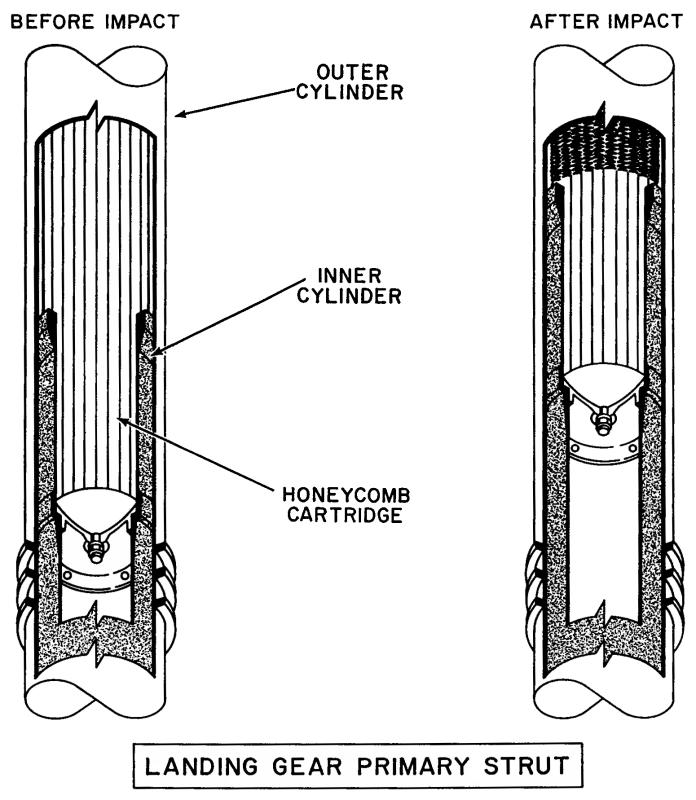Lunar Module Landing Gear Strut Crushable Honeycomb
The lunar module needed some sort of shock absorber to cushion the impact of landing on the moon. Once the contact probes touched the lunar surface, the descent propulsion system engine would be shut off, and the LM would drop the remaining distance to the ground.
Weight was an overriding concern with the LM, so anything particularly heavy-duty would probably also be too heavy. However, since the shock absorbers had to work only once, this allowed some flexibility in its design.
From Tom Kelly's Moon Lander:
... Concerned about the weight and potential for leakage of fluid into space from conventional hydraulic or pneumatic energy absorbers, I insisted on a dry version. In the proposal we thought it would be some form of molded elastic compound, but as the design evolved into an extendible four-legged landing gear a new energy absorbing material had to be developed to dissipate sufficient energy in a short stroke. Jiggs and Marcy searched for suitable materials and came up with crushable aluminum honeycomb. Hexcell had developed aluminum honeycomb as a lightweight, rigid, high-strength filler material for aircraft control surfaces, particularly the trailing edges, which typically taper down to end in a point. Hexcell was exploring new uses for its material and believed that it could be configured as a highly efficient energy absorber for the LM landing gar. Marcy designed some test struts for which Hexcell fabricated cylindrical slugs of crushable honeycomb. The initial test results were very promising: they indicated that the amount of energy that could be absorbed by a three- to four-inch diameter honeycomb cylinder with a crushable stroke of twenty-four to thirty-six inches was in the range required by the LM's landing conditions. I asked Jiggs to proceed with the landing gear design using this approach, and we authorized Hexcell to conduct a development program to characterize and optimize crushable honeycomb for energy absorption.
The Apollo Spacecraft News Reference (Lunar Module) [direct link to 4.5 meg PDF; part 2 of the Lunar Module News Reference at Indiana University's Apollo Technical Data Library] elaborates:
The strut is of the piston-cylinder type; it absorbs the compression load of the lunar landing and supports the LM on the lunar surface. Compression loads are attenuated by a crushable aluminum-honeycomb cartridge in each strut. Maximum compression length of the primary strut is 32 inches. The aluminum honeycomb has the shock-absorbing capability of accepting one lunar landing. This may include one or two bounces of the LM, but after the full wight of the LM is on the gear, the shock absorbing medium is expended. Use of compressible honeycomb cartridges eliminated the need for thick-walled, heavy-weight, pneudraulic-type struts.
Kelly goes on to state that, while the crushable honeycomb was designed for an impact of up to ten feet per second, no mission landed at more than four feet per second. This resulted in the struts not collapsing very far, which in turn made slightly longer step down off the LM's ladder. On Apollo 11, Armstrong comments about this (scroll down to time code 109:22:59 at the Apollo Lunar Surface Journal): "I just checked getting back up to that first step, Buzz. It's...The strut isn't collapsed too far, but it's adequate to get back up."
Click image for a 1550x1782 pixel version of this image in a new window.
Adapted from p. 6 of Apollo 11
LM-5 Structures Handout
Extraction and cleanup by heroicrelics.

